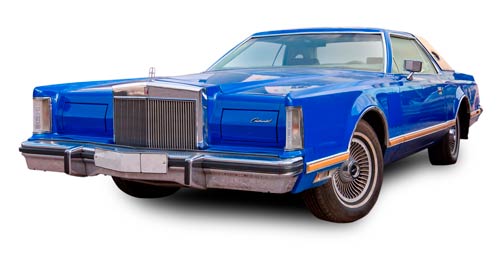During the auto industry’s earlier decades, steel was the material of choice for engineers and manufacturers. Why? The answer won’t surprise you – steel was the favorite thanks to its strength, durability and cost effectiveness.
However, in the second half of the 20th Century, changes in market conditions forced automakers to reconsider their material choices. They turned to plastics and other metals, primarily aluminum. Today, we’ll focus on aluminum from that time and into the future.
Time for A Change
Aluminum started gaining the attention of the auto industry in the 1970’s, during the oil crisis. Increased fuel efficiency quickly became the number one priority. This forced manufacturers to reduce overall vehicle weight by using lighter materials. Plastics quickly replaced steel and other materials in many components ranging from dashboards and trim pieces, and gradually into structural parts such as bumpers and fenders.
Plastics came with attractive advantages including weight reduction, design flexibility and corrosion resistance. However, these advantages also came with major drawbacks such as durability and recyclability. At the time, environmental concerns continued to grow, while performance demands also increased.
 |
 |
|
| 1978 Lincoln Mark V Weight: 4,960# Length: 230.3” Gas Mileage: 8-14 MPG |
VS | 2025 Chevrolet Trax Weight: 2,983# Length: 179” Gas Mileage: 20-32 MPG |
Why Automakers Chose Aluminum
The auto industry needed the best of both worlds: steel’s strength and durability, and plastic’s light weight and corrosion resistance. Turns out, these are precisely the defining characteristics of aluminum, in addition to a few more. Let’s look closer at each:
Weight – Aluminum is approximately one-third the weight of steel, yet maintains similar strength characteristics. This significant reduction of weight means better fuel economy and performance, with reduced emissions.
Strength – aluminum alloys have strength ranges very close to those of steel. Though steel has slightly better absolute strength, aluminum has a much better strength-to-weight ratio – exceeding steel by 50-70%. This means engineers can achieve very similar structural performance, with much less material.
Corrosion Resistance – Steel requires extensive coating and treatment to prevent rust, while aluminum naturally produces a protective oxide layer. This is particularly a concern for regions that have harsh winters, and cover roads with salt to control ice. The salt in turn causes corrosion, and premature exterior deterioration in vehicles.
Recyclability – aluminum enjoys a reputation of being “infinitely recyclable”, meaning it can be reprocessed without losing its properties. Further, recycled aluminum requires about 5% of the energy it takes to produce new aluminum from ore. This adds to the overall environmental benefits of aluminum.
Thermal Conductivity – aluminum’s conductivity is roughly 5 times higher that steel. This makes it very effective at dissipating heat from systems and parts such as engines, brakes and electric components in both conventional and electric vehicles.
Formability and Workability – aluminum can be shaped into complex geometries more easily than steel. This enables manufacturers to innovate as the improve both aesthetics and functionality, often giving them a competitive edge.
Aluminum Applications in Today’s Vehicles
Aluminum adoption by the auto industry has expanded beyond traditional uses, with the material now found throughout modern vehicles:
Electric Vehicle Components
- Battery Pack Enclosures and Supports – Aluminum’s lightweight nature and thermal management properties make it ideal for EV battery systems
- Electrical Connectors/Wiring Harnesses – aluminum’s excellent conductivity and corrosion resistance ensure reliable electrical connections
- Cooling System Components – Heat exchangers, radiators, and thermal management systems all benefit from aluminum’s impressive thermal properties
Structural and Chassis Components
- Space Frames and Body Structures – vehicles are increasingly relying on aluminum space frames for weight reduction without compromising safety
- Suspension components – Control arms, knuckles, and other suspension parts benefit from aluminum’s strength-to-weight ratio
- Wheels and brake components – aluminum wheels have become standard, with brake calipers and rotors quickly catching up
Interior and Convenience Features
- Seat Brackets/Adjustment Mechanisms – thanks to aluminum, these can help reduce overall vehicle weight while maintaining their structural integrity
- Bumper Brackets/Reinforcements – these hidden structural components also benefit from lighter weight, while still providing safety benefits
- Dashboard/Trim Components – Decorative and functional interior elements made from aluminum benefit from design flexibility while contributing weight savings
Aluminum’s Expanding Role
Based on the trend that started over half a century ago, aluminum’s role in auto manufacturing is likely to continue increasing in the coming years. There are many signs to support this. Alloys that are under development aim to deliver even better strength-to-weight ratios, and other enhancements. Its recyclability also contributes to the circular economic initiatives, which are becoming increasingly important to manufacturers and consumers worldwide. Aluminum’s unique combination of properties – lightweight, corrosion-resistant, thermally conductive, and being infinitely recyclable – makes it an ideal material for the vehicles of tomorrow. The question is no longer whether aluminum should replace steel in automotive applications, but how quickly and completely will this transformation happen.

